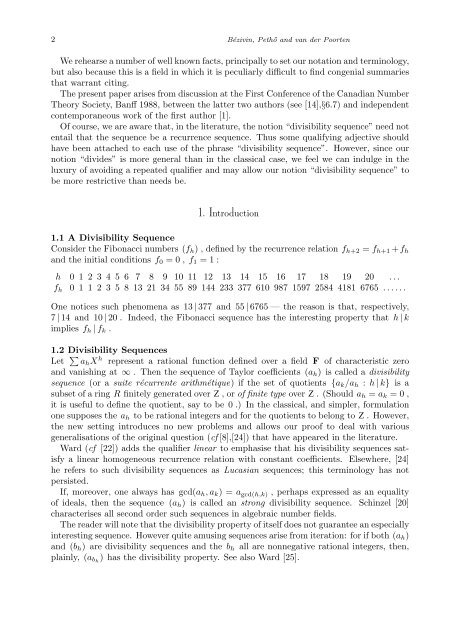A FULL CHARACTERISATION OF DIVISIBILITY SEQUENCES ...
A FULL CHARACTERISATION OF DIVISIBILITY SEQUENCES ...
A FULL CHARACTERISATION OF DIVISIBILITY SEQUENCES ...
Create successful ePaper yourself
Turn your PDF publications into a flip-book with our unique Google optimized e-Paper software.
2 Bézivin, Pethő and van der Poorten<br />
We rehearse a number of well known facts, principally to set our notation and terminology,<br />
but also because this is a field in which it is peculiarly difficult to find congenial summaries<br />
that warrant citing.<br />
The present paper arises from discussion at the First Conference of the Canadian Number<br />
Theory Society, Banff 1988, between the latter two authors (see [14],§6.7) and independent<br />
contemporaneous work of the first author [1].<br />
Of course, we are aware that, in the literature, the notion “divisibility sequence” need not<br />
entail that the sequence be a recurrence sequence. Thus some qualifying adjective should<br />
have been attached to each use of the phrase “divisibility sequence”. However, since our<br />
notion “divides” is more general than in the classical case, we feel we can indulge in the<br />
luxury of avoiding a repeated qualifier and may allow our notion “divisibility sequence” to<br />
be more restrictive than needs be.<br />
1. Introduction<br />
1.1 A Divisibility Sequence<br />
Consider the Fibonacci numbers (fh) , defined by the recurrence relation fh+2 = fh+1 + fh<br />
and the initial conditions f0 =0, f1 =1:<br />
h 0123456 7 8 9 1011 12 13 14 15 16 17 18 19 20 ...<br />
fh 011235813213455891442333776109871597 2584 4181 6765 . .....<br />
One notices such phenomena as 13 | 377 and 55 | 6765 — the reason is that, respectively,<br />
7 | 14 and 10 | 20 . Indeed, the Fibonacci sequence has the interesting property that h | k<br />
implies fh | fk .<br />
1.2 Divisibility Sequences<br />
Let ahX h represent a rational function defined over a field F of characteristic zero<br />
and vanishing at ∞ . Then the sequence of Taylor coefficients (ah) is called a divisibility<br />
sequence (or a suite récurrente arithmétique) if the set of quotients {ak/ah : h | k} is a<br />
subset of a ring R finitely generated over Z ,orof finite type over Z . (Should ah = ak =0,<br />
it is useful to define the quotient, say to be 0 .) In the classical, and simpler, formulation<br />
one supposes the ah to be rational integers and for the quotients to belong to Z . However,<br />
the new setting introduces no new problems and allows our proof to deal with various<br />
generalisations of the original question (cf [8],[24]) that have appeared in the literature.<br />
Ward (cf [22]) adds the qualifier linear to emphasise that his divisibility sequences satisfy<br />
a linear homogeneous recurrence relation with constant coefficients. Elsewhere, [24]<br />
he refers to such divisibility sequences as Lucasian sequences; this terminology has not<br />
persisted.<br />
If, moreover, one always has gcd(ah,ak) =agcd(h,k) , perhaps expressed as an equality<br />
of ideals, then the sequence (ah) is called an strong divisibility sequence. Schinzel [20]<br />
characterises all second order such sequences in algebraic number fields.<br />
The reader will note that the divisibility property of itself does not guarantee an especially<br />
interesting sequence. However quite amusing sequences arise from iteration: for if both (ah)<br />
and (bh) are divisibility sequences and the bh all are nonnegative rational integers, then,<br />
plainly, (abh ) has the divisibility property. See also Ward [25].
















